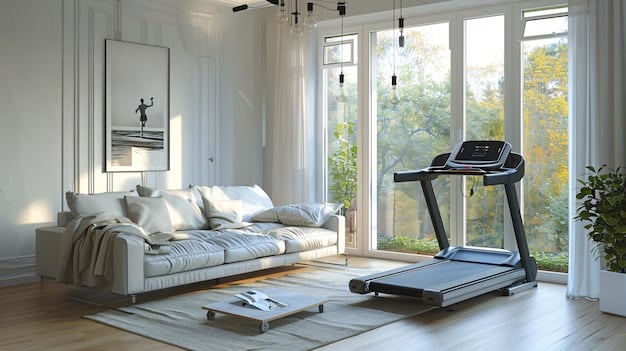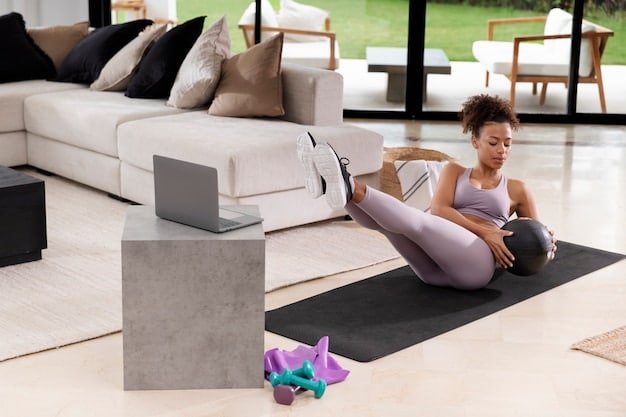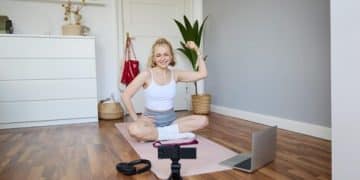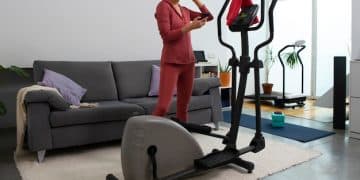The Ultimate Guide to Building a Home Gym on a Budget

The Ultimate Guide to Building a Home Gym on a Budget provides practical, budget-friendly strategies for creating an effective workout space at home. Learn to prioritize essential equipment, utilize DIY solutions, and maximize small spaces to achieve your fitness goals without breaking the bank.
Embarking on a fitness journey doesn’t always require an expensive gym membership. In fact, creating your own workout sanctuary is more attainable than you might think. This guide explores practical and cost-effective ways to build your dream home gym.
Whether you’re a seasoned athlete or just starting out, the ultimate guide to building a home gym on a budget will equip you with the knowledge to design a personalized fitness space that suits your needs and preferences. Let’s dive in and transform a corner of your home into a powerful fitness hub!
The Ultimate Guide to Building a Home Gym on a Budget: Assessing Your Needs
Before you start buying equipment, it’s crucial to assess your fitness goals and available space. This step ensures you invest in equipment that aligns with your workout routine and fits comfortably within your home.
Defining Your Fitness Goals
What do you want to achieve with your home gym? Are you aiming to build strength, improve cardiovascular health, increase flexibility, or all of the above? Clearly defining your goals will help you prioritize the right equipment and exercises.
- Strength Training: Focus on equipment like dumbbells, resistance bands, and a pull-up bar.
- Cardio: Consider a jump rope, or look for affordable used treadmills or stationary bikes.
- Flexibility: Yoga mats, resistance bands, and foam rollers are great additions for stretching and mobility work.
Evaluating Your Space
Measure the area you plan to use for your home gym. Consider ceiling height, floor space, and ventilation. A small space can still be effective with the right layout and multi-functional equipment.
Proper planning during the ultimate guide to building a home gym on a budget will result in greater functionality, reduced money wasted purchasing non-essential items, and a higher likelihood that you use the gym frequently.
In this first section, it’s critical to define key goals and objectives for your home gym. By knowing in advance if the priority is strength, resistance, mobility or a combination of all three, you will save money on expensive exercise equipment you don’t need. Likewise, taking stock of precisely how much space is available can avoid unnecessary logistical headaches and the purchase of items that won’t even fit.
Prioritizing Essential Equipment for Your Budget Home Gym
With your goals and space in mind, it’s time to prioritize essential equipment. Start with versatile items that offer multiple workout options and provide the most value for your money.

Resistance Bands: A Versatile Choice
Resistance bands are an excellent investment for building strength and flexibility. They are affordable, portable, and can be used for a wide range of exercises. Look for a set with varying resistance levels to accommodate different muscle groups and fitness levels.
Dumbbells: Building Strength
A set of dumbbells is a fundamental addition to any home gym. Start with a few pairs of different weights to challenge yourself as you get stronger. Adjustable dumbbells are a space-saving option if you have limited room.
- Adjustable Dumbbells: These allow you to change the weight quickly and easily, saving space and money.
- Kettlebells: Another versatile option for strength and cardio workouts.
- Pull-Up Bar: Perfect for upper body strength training.
Remember that you do not need every high end exercise equipment ever conceived. Focus on the items that accomplish the core needs defined in the first section and prioritize affordable, high-quality versions of those essential items. The ultimate guide to building a home gym on a budget will focus on those essentials.
This section focuses on the essentials that provide a wide range of options. Resistance bands, simple dumbbells, and a pull-up bar collectively can accomplish far more than many realize if used correctly. Selecting these items can allow you to build an impressive home gym on a tight budget.
DIY Solutions and Creative Alternatives
Get creative and use DIY solutions to save even more money. Everyday household items can be repurposed into effective workout tools, and DIY projects can be a fun way to personalize your gym.
Repurposing Household Items
Think outside the box and find new uses for items you already have. This is the essence of the ultimate guide to building a home gym on a budget. The savings from these repurposed items can be put towards those couple of things you really want!
- Water Jugs: Fill empty water jugs with sand or water for DIY weights.
- Towels: Use rolled-up towels as padding for floor exercises.
- Chairs: Sturdy chairs can be used for tricep dips or elevated push-ups.
DIY Gym Equipment
With a little effort, you can build your own gym equipment. DIY projects not only save money but also allow you to customize your gym to your exact specifications. Get creative!
When implementing these DIY projects, be sure to build for safety and durability. Poorly constructed weights or benches can be dangerous to use, resulting in injury. Check all DIY projects to ensure the hardware is securely connected and that materials used are up to the task.
Simple and creative DIY solutions can stretch the budget and maximize impact. Instead of buying pricey equipment or mats, things you already have around the home can be substituted in nearly all cases. In many DIY projects, you can also create a heavier or more durable version, which will suit some users better than the commercial counterparts.
Maximizing Small Spaces for Your Home Gym
Limited space shouldn’t limit your fitness routine. With smart planning and space-saving strategies, you can create an effective home gym, no matter how small your area is.
Multi-Functional Equipment
Choose equipment that serves multiple purposes. A foldable workout bench can be stored away when not in use, and resistance bands can be used for a variety of exercises in any corner of your home.
Vertical Storage Solutions
Utilize vertical space to store your equipment. Wall-mounted racks, shelves, and hooks can keep your gym organized and free up floor space.

Mirrors can also make a room seem larger than it is while also allowing you to have greater precision and form while exercising and lifting. Do not underestimate the visual impact that mirrors can have on the look and feel of the room.
Even the smallest spare closets can be converted into a highly functional and effective home gym. The ultimate guide to building a home gym on a budget must consider the challenge of space limitations. With foresight and creativity, that challenge can be easily overcome.
Small spaces require more planning and finesse. By using space-saving solutions and multi-functional equipment, the smallest room can feel much bigger and function as a high-impact personal home gym.
Maintaining Motivation and Staying Consistent
Building a home gym is just the first step. Staying motivated and consistent with your workouts is essential for achieving your fitness goals. This part of the ultimate guide to building a home gym on a budget involves creating an encouraging environment and workout plans.
Setting Realistic Goals
Start with achievable goals and gradually increase the intensity and duration of your workouts. Celebrate your progress along the way to stay motivated.
Creating a Workout Schedule and Routine
Schedule your workouts like any other important appointment. Having a consistent routine helps you stay on track and make fitness a regular part of your life. This helps create consistency.
- Track Your Progress: Keep a workout journal or use a fitness app to monitor your progress and stay motivated.
- Find a Workout Buddy: Exercising with a friend or family member can provide support and accountability.
- Reward Yourself: Set milestones and reward yourself for reaching them.
If you find that you are easily distracted during your scheduled workouts, consider posting a “do not disturb” sign to minimize the likelihood of outside disruption. Also, consider powering off or silencing your phone to remove unwanted social media and work notifications. Creating a space free from distraction increases efficiency and focus.
Motivation is critical to staying consistent. Without a structured workout plan and a means to measure progress, motivation will fall rapidly. By creating a realistic plan and timeline and measuring results along the way to highlight momentum, motivation can be maintained long term.
Finding Deals and Discounts for Your Home Gym
Building a home gym on a limited budget requires smart shopping. Look for deals, discounts, and used equipment to save money without compromising on quality. Finding these deals is paramount to this ultimate guide to building a home gym on a budget.
Shopping for Used Equipment
Check online marketplaces, local classifieds, and thrift stores for used gym equipment. You can often find high-quality items at a fraction of the retail price. Ensure the items are clean and safe before purchasing.
When purchasing used equipment, always examine it closely. Weight lifting equipment may have microfractures or stresses that are not immediately obvious, so take extra precautions before loading heavy weight onto the equipment. Likewise, ensure the equipment has not been recalled from the manufacturer for previous issues. Your health is far more valuable than saving a few dollars on an item you are unsure of.
- Online Marketplaces: Sites like Craigslist and Facebook Marketplace are great places to find used gym equipment.
- Local Gyms: Check with local gyms that may be upgrading their equipment and selling off old inventory.
Shopping used online can save serious money. However, you lose out on the warranties, return guarantees, and personal connection you may get at a local gym equipment store.
Finding deals and discounts on equipment is essential for staying within budget. Carefully and consistently compare equipment prices from different markets; a little diligence can go a long way.
| Key Point | Brief Description |
|---|---|
| 💪 Assess Needs | Define fitness goals & space available. |
| 🏋️♀️ Prioritize Equipment | Focus on versatile, multi-functional items. |
| 🔨 DIY Solutions | Get creative with household items. |
| 🔥 Stay Motivated | Set goals, track progress, and reward yourself. |
Frequently Asked Questions (FAQ)
Start with resistance bands, a set of dumbbells, and a yoga mat. These items are versatile, affordable, and can be used for a wide range of exercises, making them perfect for a budget-friendly home gym.
Consider purchasing used equipment from online marketplaces or local classifieds. DIY solutions, like using water jugs for weights, can also help you save money. Look for deals and discounts to maximize your budget.
Set realistic goals, create a workout schedule, and track your progress. Find a workout buddy for support and accountability. Reward yourself for reaching milestones to keep motivation high. Schedule specific times for exercise.
Yes! Focus on multi-functional equipment and vertical storage solutions. Maximize your space by using wall-mounted racks, yoga mats, and equipment that can be easily stored when not in use.
Get creative with household items! Use water jugs filled with sand for weights, rolled-up towels for padding, and chairs for tricep dips. DIY projects can save money and allow you to customize to your needs.
Conclusion
Creating a home gym on a budget is a realistic goal with the right planning and creativity. By assessing your needs, prioritizing essential equipment, exploring DIY solutions, and staying motivated, you can create a personalized fitness space that supports your health and wellness journey.
Remember to stay consistent, track your progress, and enjoy the convenience of working out in the comfort of your own home. With the ultimate guide to building a home gym on a budget, you can achieve your fitness goals without breaking the bank.





